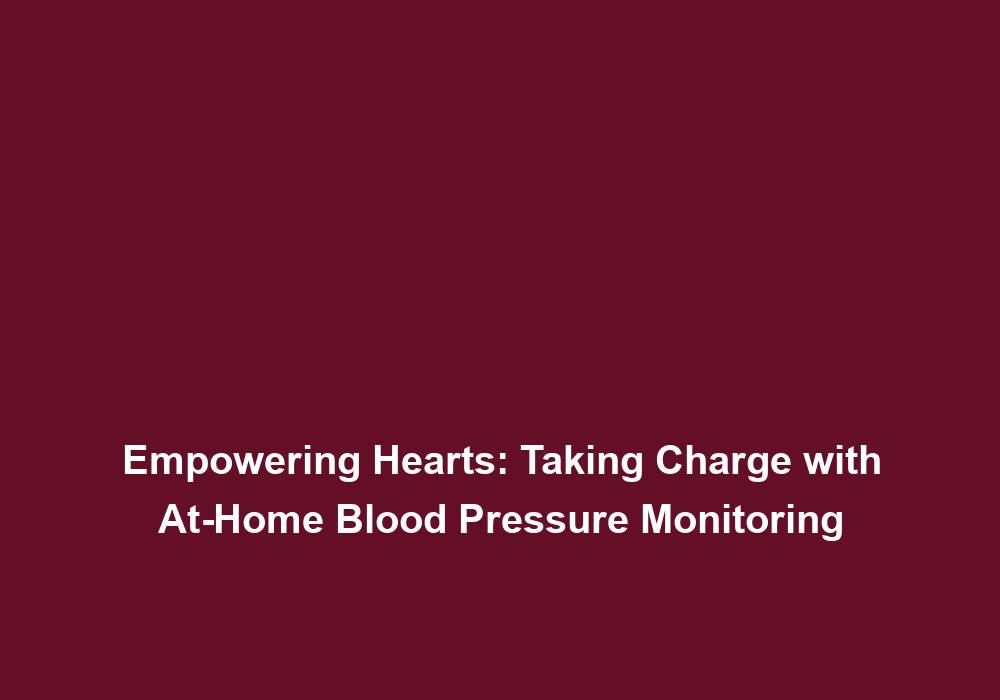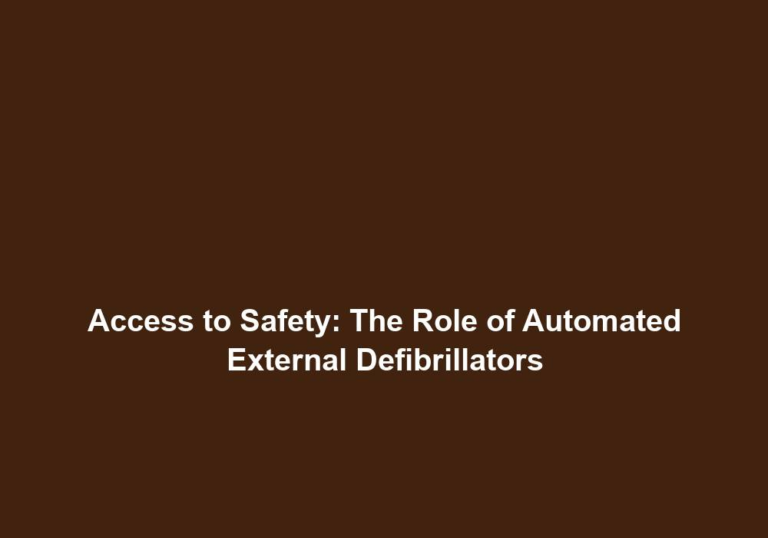Empowering Hearts: Taking Charge with At-Home Blood Pressure Monitoring
In today’s fast-paced world, health concerns have become a top priority for many individuals. One such concern that affects a large population globally is high blood pressure, also known as hypertension. High blood pressure can lead to serious health issues if left untreated, including heart disease, stroke, and kidney problems. However, with the advancement of technology, individuals can now take charge of their own health by monitoring their blood pressure at home.
The Importance of Blood Pressure Monitoring
Before delving into the benefits of at-home blood pressure monitoring, it is crucial to understand the significance of regularly monitoring blood pressure. Blood pressure is the force of blood against the walls of the arteries as the heart pumps it around the body. It is measured using two numbers – systolic pressure over diastolic pressure. The systolic pressure represents the force when the heart contracts, while the diastolic pressure is the force when the heart relaxes between beats.
Maintaining a healthy blood pressure level is essential as high blood pressure can damage the arteries and vital organs over time. It is often referred to as the silent killer as it typically presents no symptoms until it reaches dangerous levels. Regular monitoring can help individuals identify any spikes or fluctuations in their blood pressure, allowing them to take appropriate actions to manage it effectively.
The Advantages of At-Home Blood Pressure Monitoring
-
Convenience and Comfort:
-
At-home blood pressure monitoring provides individuals with the convenience of checking their blood pressure in the comfort of their own homes. This eliminates the need for frequent visits to healthcare facilities or pharmacies.
-
Individuals can choose a time that suits them best, ensuring a relaxed environment and accurate readings.
-
It also eliminates the stress and anxiety often associated with medical settings, leading to more accurate results.
-
Additionally, at-home blood pressure monitoring allows individuals to monitor their blood pressure at their convenience, whether it’s in the morning, afternoon, or evening. This flexibility ensures that individuals can consistently monitor their blood pressure without disrupting their daily routines.
-
Furthermore, monitoring blood pressure at home provides a comfortable setting where individuals can relax, ensuring more accurate readings. In a familiar environment, individuals are less likely to experience the white-coat syndrome, where blood pressure temporarily rises due to anxiety in a medical setting.
-
-
Cost-Effective:
-
Regular doctor visits for blood pressure checks can quickly add up in terms of time and money. At-home blood pressure monitoring eliminates these costs by providing a one-time investment in a reliable blood pressure monitor.
-
Individuals can save on travel expenses and co-pays, making it a cost-effective option for long-term monitoring.
-
Moreover, at-home blood pressure monitoring can help individuals avoid unnecessary medical expenses associated with frequent visits to healthcare facilities. By having the ability to monitor their blood pressure at home, individuals can identify any concerning trends or fluctuations early on and seek medical advice as needed, potentially preventing more serious health complications.
-
Additionally, the cost-effectiveness of at-home blood pressure monitoring extends beyond financial savings. By actively monitoring their blood pressure, individuals can potentially reduce their healthcare costs in the long run by proactively managing their blood pressure and preventing the development of costly health conditions.
-
-
Personalized Monitoring:
-
At-home blood pressure monitoring allows individuals to track their blood pressure readings over time, creating a comprehensive record of their health.
-
By recording daily measurements, individuals can identify patterns, triggers, or even the effects of lifestyle changes on their blood pressure.
-
This personalized monitoring empowers individuals to actively participate in their healthcare decisions and make informed choices.
-
Furthermore, at-home blood pressure monitoring enables individuals to customize their monitoring routine according to their specific needs. They can choose to monitor their blood pressure more frequently during stressful periods or after lifestyle changes, providing valuable insights into how different factors affect their blood pressure.
-
Additionally, personalized monitoring allows individuals to become more aware of their blood pressure trends and take proactive measures to maintain a healthy lifestyle. By identifying triggers or patterns that may lead to elevated blood pressure, individuals can make necessary adjustments to their diet, exercise routine, stress management techniques, and medication adherence.
-
-
Early Detection and Intervention:
-
Regular monitoring at home enables early detection of any abnormal fluctuations or elevated blood pressure levels.
-
Individuals can promptly seek medical advice or intervention if their readings consistently show high blood pressure, preventing further complications.
-
Early detection and intervention can significantly reduce the risk of developing heart disease, stroke, or other associated health problems.
-
Additionally, early detection through at-home blood pressure monitoring can lead to timely interventions, such as lifestyle modifications or medication adjustments, which can effectively manage blood pressure and prevent the progression of hypertension-related complications.
-
Moreover, at-home blood pressure monitoring empowers individuals to become proactive in their health management. By regularly monitoring their blood pressure, individuals can detect any concerning trends early on, allowing them to take timely action and work closely with their healthcare providers to develop personalized treatment plans.
-
-
Improved Treatment Compliance:
-
Studies have shown that individuals who actively monitor their blood pressure at home tend to have better treatment compliance.
-
By being actively involved in their healthcare, individuals are more likely to follow prescribed medications, adopt healthier lifestyle changes, and maintain regular check-ups with their healthcare providers.
-
Furthermore, at-home blood pressure monitoring fosters a sense of responsibility and accountability in individuals. By regularly monitoring their blood pressure, individuals can witness the direct impact of their treatment adherence and lifestyle modifications on their blood pressure readings. This visual feedback motivates individuals to stay consistent with their treatment plan, leading to improved treatment compliance.
-
Additionally, at-home blood pressure monitoring enables individuals to have a more informed and collaborative relationship with their healthcare providers. By sharing their blood pressure readings during check-ups, individuals and healthcare providers can have meaningful discussions about treatment progress, potential adjustments, and strategies for long-term blood pressure management.
-
Tips for Accurate At-Home Blood Pressure Monitoring
To ensure accurate readings and reliable monitoring, here are some tips to follow:
-
Choose a Reliable Blood Pressure Monitor:
-
Invest in a quality blood pressure monitor that is validated and approved by medical professionals.
-
Wrist and arm monitors are the most common types available, but consult your healthcare provider for the best option suited to your needs.
-
Moreover, when selecting a blood pressure monitor, consider its accuracy, ease of use, and features such as memory storage, multiple user profiles, and compatibility with mobile apps or software for data management and analysis.
-
-
Follow Proper Technique:
-
Read and understand the instructions provided with the blood pressure monitor carefully.
-
Sit in a quiet and comfortable position with your feet flat on the floor and back supported while measuring.
-
Avoid smoking, caffeine, or exercise for at least 30 minutes before taking a reading.
-
Rest for five minutes before measuring your blood pressure.
-
Place the cuff at the same level as your heart, following the monitor’s guidelines.
-
Additionally, it’s important to ensure that the cuff size is appropriate for your arm circumference. Using an ill-fitting cuff can lead to inaccurate readings. Refer to the manufacturer’s guidelines or consult your healthcare provider for proper cuff sizing.
-
-
Maintain a Routine:
-
Consistency is key to accurate monitoring. Measure your blood pressure at the same time each day.
-
Avoid taking readings immediately after waking up or consuming a heavy meal, as these can temporarily affect blood pressure levels.
-
Furthermore, establishing a monitoring routine can help individuals identify any long-term trends or patterns in their blood pressure readings. By consistently monitoring at the same time each day, individuals can observe how their blood pressure fluctuates throughout the day, allowing for better management strategies.
-
-
Keep a Record:
-
Record your blood pressure readings in a log or using a digital app, allowing you to track changes over time.
-
Note any lifestyle changes, medication adjustments, or symptoms that may impact your blood pressure.
-
Additionally, maintaining a record of blood pressure readings can provide valuable information to healthcare providers during check-ups. It allows them to assess treatment effectiveness, identify potential triggers or patterns, and make informed decisions regarding medication adjustments or lifestyle modifications.
-
Moreover, digital apps or software designed for blood pressure tracking often provide visual representations of blood pressure trends, making it easier to identify any concerning changes. These tools may also offer the ability to export data or generate reports for sharing with healthcare providers.
-
-
Regularly Review with Healthcare Provider:
-
Share your at-home blood pressure readings with your healthcare provider during regular check-ups or appointments.
-
Discuss any concerns or patterns you notice in your readings, allowing for adjustments to your treatment plan if necessary.
-
Furthermore, regular communication with healthcare providers is crucial for effective blood pressure management. By sharing at-home blood pressure readings, individuals can receive expert guidance, ensure accurate interpretation of readings, and receive timely interventions when needed.
-
Additionally, discussing any concerns or patterns noticed in the blood pressure readings can help healthcare providers gain valuable insights into the individual’s overall health and make necessary adjustments to the treatment plan. This collaborative approach ensures that individuals receive the most appropriate and personalized care.
-
Conclusion
At-home blood pressure monitoring empowers individuals to actively participate in their health management and take charge of their cardiovascular well-being. With the convenience, cost-effectiveness, and personalized monitoring it offers, individuals can detect any abnormalities early on and make informed decisions to maintain optimal blood pressure levels. However, it is essential to follow proper technique, maintain a routine, and regularly consult with healthcare providers for accurate monitoring and effective intervention strategies. By embracing at-home blood pressure monitoring, individuals can embark on a journey towards a heart-healthy lifestyle and a happier, healthier life.







